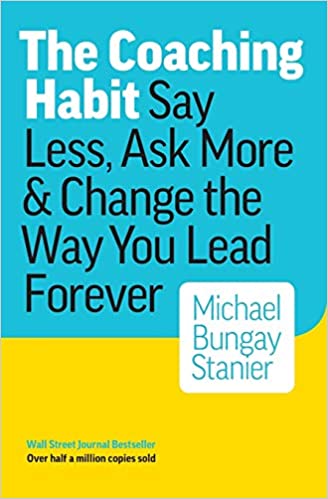This post is part of the 📖 The Coaching Habit series.
Today I am reading a new chapter How to Build a Habit from the book The Coaching Habit written by Author, Michael Bungay Stanier.
Yesterday, I started a new book and read the first chapgter You Need a Coaching Habit from Delivering a World-Class Experience chapter of the book.
Tomorrow, I will be reading a new chapter Ask One Question at a Time. Look out for tomorrow’s article.
How to Build a Habit
In this chapter, the author unpacks real science of how to change your behaviour, rather than relying on myths and lies that you’ll find on the Internet.
The change of behaviour at the heart of what this book is about is this: a little more asking people questions and a little less telling people what to do.
Duke University study says that at least 45 per cent of our waking behaviour is habitual. Although we’d like to think we’re in charge, it turns out that we’re not so much controlling how we act with our conscious mind as our subconscious or unconscious mind is driving us.
To build an effective new habit, you need five essential components:
- a reason,
- a trigger,
- a micro-habit,
- effective practice,
- and a plan
Make a Vow
Leo Babauta, the author of the book Zen Habits, talks about making a vow that’s connected to serving others. Leo gave up smoking as a commitment to his wife and newborn daughter.
Think less about what your habit can do for you, and more about how this new habit will help a person or people you care about - Leo Babauta
Figure Your Trigger
You don’t know what triggers the old behaviour; you’ll never change it because you’ll already be doing it before you know it.
The more specific you can be when defining your trigger moment, the more useful a piece of data it is.
Double-s It: Be Short & Specific
If you define your new habit in an abstract and slightly vague way, you won’t get traction. If it takes too long to do, your big brain will find a way to hack your good intentions.
You should define your new habit as a micro-habit that needs to take less than sixty seconds to complete. - BJ Fogg
Practice Deeply
Practising small chunks of the bigger action.
For instance, rather than practice the whole tennis serve, you practice just tossing the ball up.
Repetition, repetition and repetition. Do it fast, do it slowly, do it differently. But keep repeating the action.
And finally, being mindful and noticing when it goes well. When it does, celebrate success.
Plan How to Get Back on Track
When you stumble—and everyone stumbles—it’s easy to give up.
Resilient systems build in fail-safes so that when something breaks down, the next step to recover is obvious. Make your habit a resilient system.

Do you know you can listen to this book on Amazon Audible for FREE?
If you are not into reading like me, then you can listen to this book for FREE on Amazon Audible
Don't Read. Just 🎧Key Takeaways
- Align your vow with people around you. It should serve other people.
Summary
Your new habit should be small and specific to achieve. Make a vow, figure a daily trigger to start your habit regularly. Practice deeply. When you miss a day, then plan to get back on track. Shrug off your mistake and come back strong the next day.
Author(s): Michael Bungay Stanier
Part 2 of 21 in the 📖 The Coaching Habit book series.
The Coaching Habit - Day 1 | The Coaching Habit - Day 3
